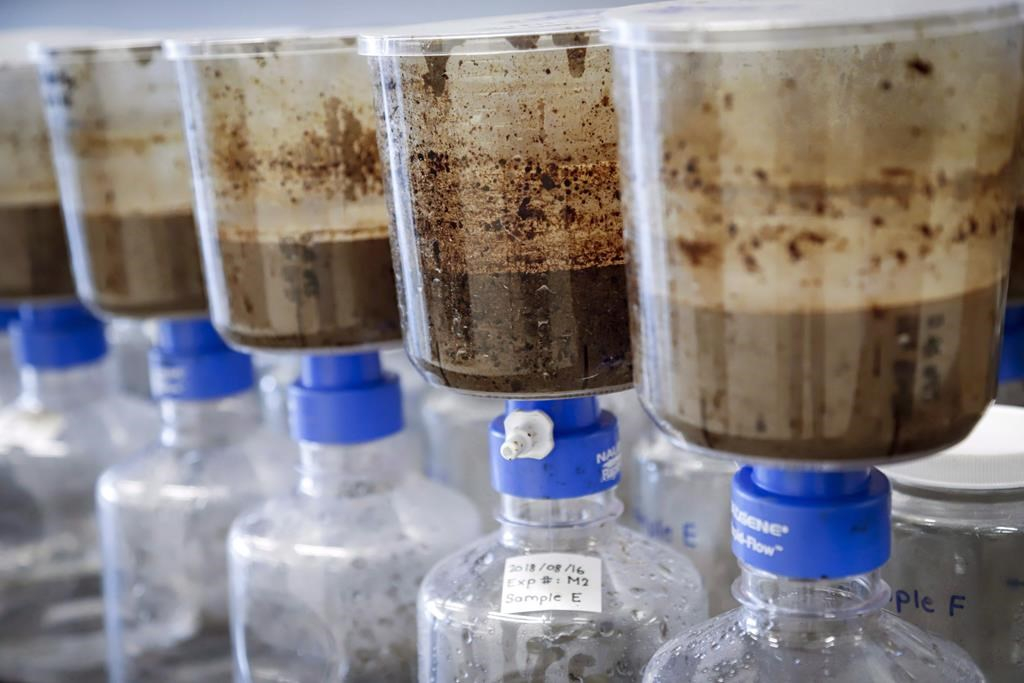CALGARY — Alberta's energy regulator may have ignored provincial law by not publicly disclosing that waste from a large oilsands tailings pond was escaping containment and seeping into groundwater, says a lawyer.
Drew Yewchuk of the University of Calgary's Public Interest Law Clinic is asking the province's Information Commissioner to investigate how and why the Alberta Energy Regulator chose not to release information on the leak at Imperial Oil's Kearl mine, despite direction in provincial law to do so.
"How do decisions about what gets reported get made?" asked Yewchuk. "They don't make any sense."
Last May, Imperial Oil reported to the Alberta Energy Regulator that it had found some brown sludge outside the boundaries of one of its Kearl tailings ponds. Over the following summer and fall, investigators determined that it had come from the pond and contained levels of several toxic contaminants that exceeded environmental guidelines.
Area First Nations were told about the original finding of sludge. However, neither they, nor the public, heard any further information until Feb. 6, when the regulator issued an environmental protection order after a second tailings release from Imperial — 5.3 million litres of wastewater that escaped a catchment pond.
Yewchuk points to sections in the Freedom of Information and Protection of Privacy Act that say any public body is obliged "without delay," to inform the public about any "risk of significant harm to the environment or to the health or safety of the public" or any information "clearly in the public interest."
That provision is to override any of the act's exceptions to mandatory disclosure, including risk of financial harm to a third party.
"This is pretty obviously going to damage the environment," Yewchuk said. "Everyone knows that tailings are unreleasably toxic."
Imperial has maintained that the releases were contained and posed no threat to water or wildlife.
"Extensive and ongoing water monitoring has confirmed that seepage has not entered local waterways," it said in a release Monday.
"There have been no impacts to local drinking water sources. There is no indication of impact to wildlife."
Yewchuk was skeptical.
"There's no way this is not going impact wildlife or human life."
The Athabasca Chipewyan First Nation, downstream from the spill, has photographed moose tracks going into the affected area. That First Nation, along with the Mikisew Cree and the government of the Northwest Territories, have expressed anger and frustration with how they were informed about the releases.
On Monday, Alberta Premier Danielle Smith said it was "unfortunate" that none of those governments were informed.
She said, however, that there was never any environmental threat and the province's environment department said none of the tailings got into tributaries.
"I think the regulator did its job by demanding a very quick resolution to this and (I am) pleased that all parties are now coming forward," Smith said.
Neither the Alberta government nor the two federal departments — Environment and Fisheries and Oceans — that have relevant regulatory responsibilities have responded to repeated questions about when they learned of the spills.
Yewchuk noted that in other cases involving small releases, the regulator has posted information on them immediately. It did so again on Monday, posting an order concerning an unknown release from a well owned by Everest Resources.
He questioned why the same wasn't done for the Kearl release.
"The information commissioner can look at those records in the original and provide a public report on what happened within the (regulator)," said Yewchuk. "I'd like to see those powers get used."
The Alberta Energy Regulator did not immediately respond to a request for comment.
Smith said the regulator and the company share responsibility for informing the public — but the onus is "principally on the company."
Meanwhile, Imperial said the cleanup is proceeding.
"All impacted surface ice and snow in the area has now been removed and safely disposed," said a Monday release from the company.
Imperial said the seepage is primarily natural groundwater and precipitation with a "small amount" of tailings. It is installing monitoring and collection wells, surface pumps and additional drainage collectors to prevent a further release.
Company vice-president Simon Young offered his "deepest apologies" for the spills.
"We are taking all necessary steps to prevent this from happening again," he said.
This report by The Canadian Press was first published March 6, 2023.
As one example of peer
As one example of peer-reviewed, objective, evidence-based documentation of toxic pollution entering the Athabasca River and surrounding landscapes from oilsands mining and processing, see the following summary from the U of Alberta, based on a paper published in the Proceedings of the National Academy of Sciences (PNAS) in the August 30, 2010 edition :
https://phys.org/news/2010-08-oilsands-polluting-athabasca-river.html
The following are some excerpts from the above summary article link:
"The 13 elements being discharged include mercury, arsenic, lead, cadmium and several other metals known to be toxic at trace levels."
"'Given the large amounts of pollutants released, any monitoring program that cannot detect increases in the environment must be considered as incompetent,' says Schindler, referring to the Regional Aquatic Monitoring Program."
"'Rather than pollutants increasing continuously downstream in the river due to natural sources, as government has claimed, concentrations of the majority of toxins were always highest near sites of industrial activity,' Schindler says."
"He notes however that concentrations of many contaminants remained above background levels right up to the Athabasca Delta. Elevated concentrations were in Lake Athabasca, near Fort Chipewyan."
"The releases are in clear violation of section 36, subsection 3 of the Fisheries Act, which prohibits discharge of toxins in any quantity into fish-bearing waters."
I cannot think of a better, nor more disturbing summation than that written by this late, internationally esteemed American/Canadian limnologist:
"Schindler says much of the debate over the impact of oilsands has been based on a combination of conjecture and propaganda, which has not been peer reviewed or published in recognized scientific publications."






Comments